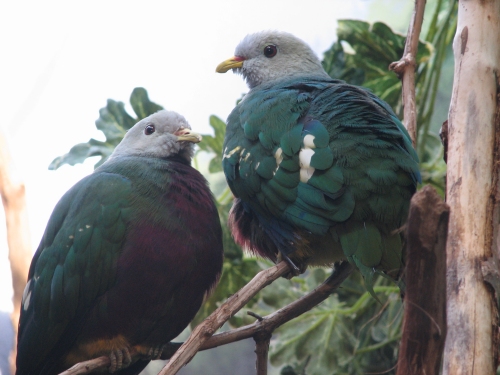Wompoo Fruit-dove (Ptilinopus magnificus) - Wiki Wompoo Fruit-dove
From Wikipedia, the free encyclopedia
Order: Columbiformes
Family: Columbidae
Synonyms: Megaloprepia magnificus
[Photo] Wompoo Fruit-doves (Ptilinopus magnificus). Photo by Ltshears. License: public domain.
The Wompoo Fruit-dove, Ptilinopus magnificus (also known as Magnificent Fruit-dove or Purple-breasted Fruit-dove), is the largest of fruit-doves native to New Guinea and Australia.
In Australia, it inhabits almost exclusively the lowland tropical rainforests along the eastern coast, from central New South Wales to the tip of Cape York Peninsula. Abundancy of the birds increase in a northerly direction.
The dove measure up to 45 centimetres (18 inches) in length but are larger in southern regions. It has purple plumage around its neck, chest and upper belly. Its lower belly is yellow and has a green underparts. The sexes look similar and the juveniles have a duller and greener plumage compared to adults. Notwithstanding their bright plumage, they are hard to see amongst the forest canopy, not the least thanks to their unobtrusive, quiet habits (Frith et al. 1976).
The birds feed off fruit-bearing trees in rainforests such as figs. They can eat large fruits whole and are able to acrobatically collect fruit of trees and vines. They do not like to travel long distances, preferring to stay in their local area and make use of whatever fruit are in season. The diet of this species was extensively studied in the Port Moresby area by Frith et al. (1976). Despite their small size, they are able to swallow fruits of 5 cm³ volume, which would translate into a diameter of about 2 cm in spherical fruit. Major food items included:
Figs, including Ficus albipila, Ficus benjamina, Ficus drupacea, Ficus glaberrima, Ficus virens and Ficus wassa - preferentially in the late dry and wet season (October - March)
Fruit of cinnamon trees (Cinnamomum sp.), Litsea, Neolitsea and Cryptocarya - whenever available
Arecaceae (palm) fruit, including Archontophoenix, Arenga, Calamus and Caryota - mid-late dry season (August - October) and January
Annonaceae fruit, such as Ylang-ylang (Cananga odorata) and Polyalthia - whenever available
Food items of minor importance were fruit of:
Eugenia, Syzygium, Acmena - important in May
Hypserpa - important in July/August
Planchonella - important August - October
Elaeocarpus - important in October
Erythroxylon scarinatum - important in November/December
Tinospora smilacina, Glochidion, Gomphandra australiana, Gomphandra montana, Cayratia, Cissus, Terminalia, Diospyros, Chionanthus, Vitex cofassus, Alocasia, and Psychotria - taken as available
The Wompoo Fruit-dove can be seen in large flocks where food is abundant. Their call sounds like ‘wollack-wa-hoo’ and often sounds very human. Breeding times will vary according to weather conditions. The nest is sturdily constructed from forked twigs not high from the ground. Both genders help in the construction of the nest. One white egg is laid and the parents share the incubation and care of the chick. In the event, that the chick dies, the doves will attempt to have a second offspring in the same season.
Widespread and common throughout its large range, the Wompoo Fruit-dove is evaluated as Least Concern on the IUCN Red List of Threatened Species.
More Photos
http://commons.wikimedia.org/wiki/Ptilinopus_magnificus
http://en.wikipedia.org/wiki/Wompoo_Fruit-dove
| The text in this page is based on the copyrighted Wikipedia article shown in above URL. It is used under the GNU Free Documentation License. You may redistribute it, verbatim or modified, providing that you comply with the terms of the GFDL. |
